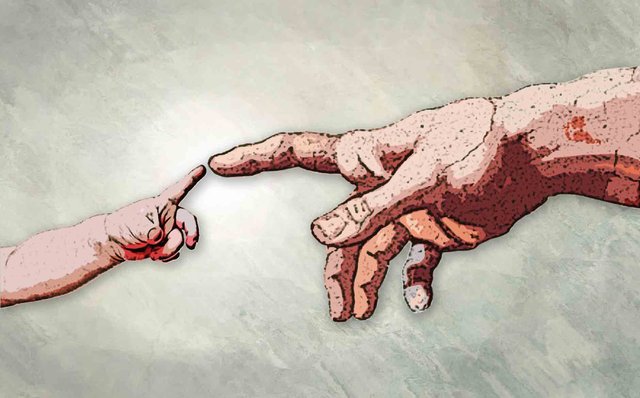Politics and Religion Pt. 4 – The Dignity of the Human Person

In this fourth post in our series on “politics and religion,” I would like to change gears a bit. Have you ever noticed that whenever the topic of abortion is discussed, the language that is constantly employed by the pro-death camp that now reaches to the highest levels of our government in America, as well as governments around the world, almost always reduces pre-born children to something less than human? Even though, again, as we saw in our last post, there is simply no argument, from a scientific perspective, and this is not to mention the philosophical or moral perspective, against what all who want to know can know to be true; namely, a human being is a human being from the moment of conception.
Yet, the constant rhetoric from the pro-abortion camp is to reduce the pre-born baby to something less than fully human. It’s a “zygote,” a “fetus,” just a bunch of cells, or the classic “potential human being.” They will call it anything but what we all know it to be: a human being! I believe this classic “culture of death” mentality, as Pope John Paul II called it, has its roots in two other “non-negotiables” I mentioned in my first post on this topic of “politics and religion:” pornography and contraception.
Pornography: the Root of the Problem
If the famous Supreme Court Justice, Potter Stewart, were still alive, I would love to steer him to CCC 2354, which gives us an excellent definition of pornography. For those who don’t know, he was the famous Justice who claimed he could never define what pornography is, but that he would “know it when he sees it:”
Pornography consists in removing real or simulated sexual acts from the intimacy of the partners, in order to display them deliberately to third parties. It offends against chastity because it perverts the conjugal act, the intimate giving of spouses to each other. It does grave injury to the dignity of its participants (actors, vendors, the public), since each one becomes an object of base pleasure and illicit profit for others. It immerses all who are involved in the illusion of a fantasy world. It is a grave offense. Civil authorities should prevent the production and distribution of pornographic materials.
The Church quite rightly declares here that in pornography we have a radical reduction of human beings to the level of sexual objects—and this is mostly women being reduced to objects to be used and abused by men! Though, unfortunately, the numbers of women not just viewing, but becoming addicted to porn is growing at an alarming rate. The truth is: once one reduces another human being to the level of an object there is no end to the evils that will most assuredly follow. Pornography, I argue, is really the unholy foundation that leads to the evils of contraception, abortion, euthanasia, and all the rest. Heaven alone will reveal the numbers of women who have been used and abused, even raped and killed stemming from this scourge of pornography.
Let me assure you, folks, that when men are looking at pornography, they are not thinking, “Boy, I wonder how her spiritual life is?” Those women are simply objects for pleasure. Faceless. And in time, they become almost something less than human. This is a mentality that leads to such horrors as rape and murder.
Does this mean all men who view pornography will rape a woman or women? No. Some will, most won’t. However, though viewing porn might not necessarily lead to rape, rape is usually preceded by the “lesser” evils of pornography and self-abuse. And I would add here that this does mean that each and every man who views pornography will have reduced the women they view to something less than what they truly are: women created in the image and likeness of God with an immeasurable and uniquely human dignity.
Contraception: the Problem Deepens
You may ask, how does pornography lead to other evils? Or more fundamentally, how does reducing another human being to the level of object lead to other evils? Let’s consider contraception. It is not rocket science to figure out that there is a two-fold end to the conjugal act. If we examine its nature, we discover the purpose of the conjugal act is both unitive, that is, it aids in bringing about the intimate union and mutual perfection of one man and one woman united in marriage, and it is procreative. In fact, the primary and most obvious reason for the conjugal act is the continuation of the species. Again, this is not rocket science. But keep this in mind as we move forward: If either the unitive or procreative aspects of the conjugal act are willfully and purposefully thwarted, that act becomes gravely immoral. It distorts the God-ordained purpose of the act itself.
Contraception willfully eliminates the essential procreative aspect of the conjugal act and effectively reduces both the man and woman, but most especially the woman, to something less than they are. Persons have become reduced to objects for sexual pleasure, contrary to God’s will.
A common objection at this point come in words to the effect of: “What about couples who are infertile for various reasons, whether it be age or some defect? Are they forbidden to have conjugal relations?” By no means! In those cases, we can say it is not God’s will for them to be able conceive. This is God’s design. (Of course, in the case of infertility, sometimes this can be healed through the proper use of medicine.) There is nothing the couple would be doing in these cases to deliberately thwart God’s plan for the conjugal act. There is, therefore, an essential difference between contraception and a couple being naturally infertile. The former acts contrary to nature; the latter acts in accord with “the laws of nature and of nature’s God” to quote the Declaration of Independence.
The tragedy of tragedies here is that contraception reduces women, especially, to sexual objects even in the context of marriage. It does not respect the woman as an integral whole. It reduces her to something less than what she is—she becomes an object for sexual gratification while acting in a way that rejects her fertility, which is an essential aspect of who she is, a sanctuary of new life and true love.
The Culture of Death
This reductionism creates a mentality that lends itself to all manner of evils both individually and collectively in societies, as Pope Paul VI so prophetically described it in Humanae Vitae, paragraphs 14 and 17. His Holiness condemns contraception absolutely because it is, by definition:
… to intend directly something which of its very nature contradicts the moral order, and which must therefore be judged unworthy of man, even though the intention is to protect or promote the welfare of an individual, of a family or of society in general. Consequently, it is a serious error to think that a whole married life of otherwise normal relations can justify sexual intercourse which is deliberately contraceptive and so intrinsically wrong.
(17) Responsible men can become more deeply convinced of the truth of the doctrine laid down by the Church on this issue if they reflect on the consequences of methods and plans for artificial birth control. Let them first consider how easily this course of action could open wide the way for marital infidelity and a general lowering of moral standards. Not much experience is needed to be fully aware of human weakness and to understand that human beings—and especially the young, who are so exposed to temptation—need incentives to keep the moral law, and it is an evil thing to make it easy for them to break that law. Another effect that gives cause for alarm is that a man who grows accustomed to the use of contraceptive methods may forget the reverence due to a woman, and, disregarding her physical and emotional equilibrium, reduce her to being a mere instrument for the satisfaction of his own desires, no longer considering her as his partner whom he should surround with care and affection.
Finally, careful consideration should be given to the danger of this power passing into the hands of those public authorities who care little for the precepts of the moral law. Who will blame a government which in its attempt to resolve the problems affecting an entire country resorts to the same measures as are regarded as lawful by married people in the solution of a particular family difficulty? Who will prevent public authorities from favoring those contraceptive methods which they consider more effective? Should they regard this as necessary, they may even impose their use on everyone. It could well happen, therefore, that when people, either individually or in family or social life, experience the inherent difficulties of the divine law and are determined to avoid them, they may give into the hands of public authorities the power to intervene in the most personal and intimate responsibility of husband and wife…
Consequently, unless we are willing that the responsibility of procreating life should be left to the arbitrary decision of men, we must accept that there are certain limits, beyond which it is wrong to go, to the power of man over his own body and its natural functions—limits, let it be said, which no one, whether as a private individual or as a public authority, can lawfully exceed. These limits are expressly imposed because of the reverence due to the whole human organism and its natural functions, in the light of the principles We stated earlier, and in accordance with a correct understanding of the “principle of totality” enunciated by Our predecessor Pope Pius XII.
This mentality and the tendencies that Pope Paul VI speaks of leads to what Pope John Paul II called “the culture of death.” It is a mentality that says we can and must eliminate anything—or anyone—that stands in the way of our being able to fulfill our own desires for pleasure—and whenever we want to! Without respect of God’s will, God’s plan, or the dignity of the other person or persons involved. So what happens when a baby “accidentally” comes along? Let’s get rid of it!
And if we look at what is happening in China with its horrid “one child” policy enforced in sometimes unthinkably brutal ways, and now the “HHS Mandate” of the Obama administration, Pope Paul VI’s words are even more profound. And this is not to mention the devastation contraception has wreaked on marriage and the family.
Sin Makes You Stupid
This “culture of death” mentality leads to all sorts of inane justifications for what is simply radical narcissism. How many times have we heard, “I am only thinking of the baby. I am not ready to raise a child!” Hogwash! Isn’t it amazing how people can kill someone and say, “It’s for your own good! Really it is!” That is just garbage. And, of course, more commonly, the person considering abortion disassociates what is commonly referred to as “the product of conception” from “a baby” at all. “The baby” is so radically objectified to the point of considering him to be just so much “biological matter” in the womb. The truth is, millions of babies have been and are being slaughtered for the simple reason that they are an inconvenience. Well, this mentality has not only led to the demise of over 55 million babies in the US alone since 1973, but it has also led to the next of our six non-negotiables:
Euthanasia
CCC 2277 declares:
Whatever its motives and means, direct euthanasia consists in putting an end to the lives of handicapped, sick or dying persons. It is morally unacceptable.
Thus an act or omission which, of itself or by intention causes death in order to eliminate suffering constitutes a murder gravely contrary to the dignity of the human person and to the respect due to the living God his creator.
One can readily see the same “culture of death” mentality that would say we must rid ourselves of pre-born babies because they are an inconvenience to us leading to “euthanasia,” which is so often getting rid of a “burden” cloaked in “compassion.” Now, there is no doubt that euthanasia can be the result of a genuinely misguided sense of compassion, but again as the Catechism says, no matter what the motives, we are talking about murder.
Let’s Be Clear
Opposition to euthanasia does not mean one has to use every possible means available to keep people alive at all times. CCC 2278 says:
Discontinuing medical procedures that are burdensome, dangerous, extraordinary, or disproportionate to the expected outcome can be legitimate; it is the refusal of “over-zealous” treatment. Here one does not will to cause death; one’s ability to impede it is merely accepted. The decisions should be made by the patient if he is competent and able or, if not, by those legally entitled to act for the patient, whose reasonable will and legitimate interests must always be respected.
We should also note here as CCC 2279 says, that one can give palliative care to someone who is in terrible pain, even if that medicine may well shorten their lifespan, as long as one is not willing death as either an end or means. If one is simply trying to alleviate pain in the context of having accepted that death is unavoidable, this can be an act of charity.
The key here is to note that any act or omission which of itself or by intention causes death is murder. Period. That is the essence of euthanasia.
I remember people used to say, “Well, that’s really not happening in the United States is it?” Well, not any more! We have now had a clear case of Euthanasia carried out before all the world. It was basically presented on live TV, in the case of Terri Schiavo, on March 18, 2005, when her feeding tube was finally removed. They did not show her actual death from starvation 13 days later on March 31, 2005, but we saw all that led up it. Gee! I wonder why they did not allow the world to see her actual death?
Perhaps the same reason why Hitler did not want the extermination of Jews to be shown in the local movie theatres in Berlin?
Here was a woman who was starved to death before the entire world! Folks, that is an example par excellence of Euthanasia! And don’t think it does not happen on a regular basis in our country. This is what happens when human beings are reduced to the level of animals that can be used up and thrown away at will.
Some will ask at this point? But wasn’t Terri Shiavo receiving nutrition and hydration through a feeding tube? Isn’t this a case of “extraordinary means” that are not required to be used? The answer is no! There is a difference between using “extraordinary means” to keep someone alive beyond what can be reasonably seen to be their time to die and using “out of the ordinary” means to give someone what is their right, that is, food and water.
On March 20, 2004, near the end of the Rome conference on the “vegetative” state, Pope St. John Paul the Great delivered a very important message reaffirming and clarifying our moral obligation to provide normal care to patients who are commonly referred to as being in a “persistent vegetative state.” The Holy Father made five key points:
- No living human being ever descends to the status of a “vegetable” or an animal. “Even our brothers and sisters who find themselves in the clinical condition of a ‘vegetative state’ retain their human dignity in all its fullness,” he said. “The loving gaze of God the Father continues to fall upon them, acknowledging them as his sons and daughters, especially in need of help.” He spoke against what he called a “quality of life” criterion used to decide who lives and who dies that would make discriminatory judgments about the worthiness of different people’s lives. The Church insists that “the value of a man’s life cannot be made subordinate to any judgment of its quality expressed by other men.”
- Because this life has inherent dignity, regardless of its visible “quality,” it calls out to us for the normal care owed to all helpless patients. In principle, food and fluids (even if medically assisted, as in tube feeding) are part of that normal care. Such feeding, he said, is “a natural means of preserving life, not a medical act.” This means, among other things, that the key question here is simply whether food and fluids effectively provide nourishment and preserve life, not whether they can reverse the patient’s illness. Even incurable patients have a right to basic care.
- This judgment does not change when the “vegetative” state is diagnosed as “persistent” or unlikely to change: “The evaluation of probabilities, founded on waning hopes for recovery when the vegetative state is prolonged beyond a year, cannot ethically justify the cessation or interruption of minimal care for the patient, including nutrition and hydration.”
- Deliberate withdrawal of food and fluids to produce a premature death can be a form of euthanasia, that is, unjust killing. “Death by starvation or dehydration is, in fact, the only possible outcome as a result of their withdrawal. In this sense it ends up becoming, if done knowingly and willingly, true and proper euthanasia by omission.”
- The Church’s traditional teaching, that one is not obliged to impose useless or excessively burdensome treatments on patients, remains valid. The obligation to provide assisted feeding lasts only as long as such feeding meets its goals of providing nourishment and alleviating suffering.
Thus, we must conclude as Catholics that every human person has a right to nutrition and hydration as long as, as Pope St. John Paul II said, the food and fluids effectively provide nourishment and preserve life. In fact, when the body permanently loses its ability to metabolize food and use water to hydrate itself, the food and fluids can actually become a cause of harm to the person rather than a cause of health and vitality. This seems to be a built-in way of the body to say it is time to move on to eternity.
Extraordinary Means
So how do we distinguish between ordinary and extraordinary means?
“Extraordinary means” of keeping people alive would be, for example, using a ventilator and other means of sustaining the bodily functions of someone who is clinically dead. In this case, you are simply keeping a body functioning when the person has already died. If it is determined that you have the irreversible cessation of all the vital activity of the brain, for example, meaning both the cerebral hemispheres and the brain stem are no longer functioning and you have the loss of the function of the brain cells, the person is dead. The body of this person does not have to be kept alive.
Or, we could consider the case of resuscitating someone who is terminally ill and in terrible pain. The decision “not to resuscitate” in these cases or to refuse “over-zealous treatment” as the Catechism said it, should be made by the person or if he cannot do so, the family of the person who is dying, in consultation with orthodox experts in medical bioethics. We are very blessed today to be able to make a phone call and get such an expert on the other end of the phone with the advent or an organization like “The National Bioethics Center,” in Philadelphia, PA. But again, any act that directly wills or causes the death of the person is Euthanasia. If one removes the artificial means that is keeping the body alive of one who is dead, the act of removing the artificial means is obviously not the cause of death. And that is what is crucial here.
One Final Note on Euthanasia:
Unfortunately, we can now see the “culture of death” expanding with regard to what I would place as a species beneath the genus, “euthanasia,” in “physician assisted suicide.” We now have now seen five states legalize physician assisted suicide: Oregon, Washington State, Montana, Vermont and New Mexico, with New Jersey now in the process of deliberation.
Can you imagine approaching someone who is suffering terribly and offering them a “button” that all they have to do is press and they will go to sleep and never wake up? “All your pain will be gone. We will arrange everything so that all you have to do is push this little button.” St. Therese of Lisieux, a Doctor of the Church who evidently experienced some sort of temptation to this end on her deathbed, said to her sister-nurse that the nurse must not “leave near them [meaning her patients] any medicines that are poisonous” and that “I assure you, it needs only a second when one suffers intensely to lose one’s reason. Then one could easily poison oneself.” If a saint and doctor of the Church would say this from her experience of terrible pain, how many people will give in to the temptation when they are aided by the very people who should be agents of life and healing? Suicide, in and of itself, is always gravely sinful, as CCC 2281 says, though CCC 2283 says:
We should not despair of the eternal salvation of persons who have taken their own lives. By ways known to him alone, God can provide the opportunity for salutary repentance. The Church prays for persons who have taken their own lives.
In other words, we leave the judging of these to God, but we never fail to say that suicide is grave sin and those who would assist them in committing suicide incur the guilt of sin as well.
God help us!
Embryonic Stem-cell research.
The Pontifical Council for the Family, Charter of the Rights of the Family, declared in paragraph 4:
Respect for the dignity of the human being excludes all experimental manipulation or exploitation of the human embryo.
Embryonic Stem-cell research is another example and another manifestation of the culture of death in action. With the advent of this technology, we are basically using human beings for spare parts. But to put it simply folks: You cannot kill an innocent person even if your intention is to save someone else. The first principle here is: “Thou shalt not murder!” And remember, this is essentially different than someone freely donating a body part, for example a kidney, as an act of charity. First of all, the pre-born baby has no choice in the matter and secondly, the removal of the embryonic stem-cells kills the pre-born baby in the process.
It is truly amazing to us me how the major media outlets have completely distorted the real issues involved when we speak of embryonic stem-cell research. The fact is, the Catholic Church is not against stem-cell research, though I can’t count the number of times I have heard that lie promoted through the various news agencies. The Church is against embryonic stem-cell research. It is perfectly licit to use adult stem-cells to attempt to bring about all sorts of remedies for various diseases and defects because the person who donates the stem cells is not killed.
And the amazing thing about this is the fact that there have now been scores of documented cures that have resulted from the use of adult stem-cells, with more coming all the time, whereas there has not been a single cure as a result of embryonic stem-cell research! The embryonic stem-cells are problematic and tend to grow tumors and present problems. Adult stem-cells are simply more effective in accomplishing what was supposed to be the goal in the first place, namely healing people!
In my opinion, I think there is more to this from the embryonic stem-cell camp than just fighting for using these pre-born babies to heal other people. This is an example of justifying abortion and claiming it now to be “beneficial” to abort the pre-born human beings.
But at any rate, the CCC puts the Catholic position succinctly and plainly in paragraph 2275, concerning embryonic stem-cell research when it says, quoting Donum Vitae I, 5:
It is immoral to produce human embryos intended for exploitation as disposable biological material.
But think about it folks: Haven’t we seen a pattern here beginning with pornography and its reduction of human beings as objects to be used at the whim of men who want their gratification at the expense of another human being? Didn’t we see the same mentality with contraception radically and ultimately expressed in abortion and euthanasia? It only makes sense what we would then “use” these pre-born babies as so much fodder for experimentation. And again, the amazing thing here is that embryonic stem-cells do not even work—they haven’t brought about any benefit. Of course, even if they did, it would not justify using them anyway. You don’t kill an innocent human being in order to save someone else. But again, these poor babies are being destroyed without any benefit being derived from them at all! Yet again, the real root cause underlying this mess is the idea that we can use other human beings as we wish and kill them at will!
Which leads us to “non-negotiable” #4: Human Cloning.
The Congregation for the Doctrine of the Faith, in its document entitled: “Instruction on Respect for Human Life in Its Origin and on the Dignity of Procreation,” declared in I:6:
Attempts… for obtaining a human being without any connection with sexuality through… “cloning”… [is] to be considered contrary to the moral law, since [it is] in opposition to the dignity both of human procreation and of the conjugal union.
When I talked about contraception earlier I mentioned the two-fold end of the conjugal act. Contraception immediately eliminates the procreative element of the conjugal act rendering the act gravely sinful. And as Pope St. John Paul II taught so well in Familiaris Consortio 32, contraception leads:
… not only to a positive refusal to be open to life but also to a falsification of the inner truth of conjugal love, which is called upon to give itself in personal totality.
Thus, contraception ends up distorting both the unitive and the procreative aspects of the conjugal act. When it comes to “cloning,” similar to in vitro fertilization, this is gravely immoral in that it eliminates the unitive aspect of the conjugal act, eliminating the sexual union entirely. In vitro fertilization is condemned by the Church in CCC 2376-2377. By nature, it “disassociate[s] the sexual act from the procreative act” as CCC 2377 says.
Moreover, “in vitro” inherently introduces all sorts of other grave evils, such as the future father masturbating in order to get sperm to use in the process. Even worse, multiple eggs must be fertilized in order to ensure the so-called “success” of the process leaving many newly conceived human beings to be frozen or discarded. This is tantamount to multiple abortions. And, in a case where the husband is infertile, or the wife does not have eggs or her eggs are “old” or otherwise “non-viable,” a third party is introduced into the equation rendering the act even more gravely immoral.
“Cloning” similarly involves multiple abortions because of the necessity of creating multiple clones with only one (or perhaps a very few in the case of “twins” or “triplets”), being allowed to be born. And when you consider the nature of cloning, we introduce another problem. Cloning completely disassociates the conjugal act from procreation because, in a sense, what you are doing is creating a “delayed identical twin,” except without the conjugal act being involved at all. The process of “cloning” involves the removal of the genetic material from the cell of an adult and placing it into the ovum (or egg) of a woman that has had its genetic material removed as well. The result is what amounts to an identical twin being born many years after the birth of its older sibling that donated the genetic material in this process. (I should note here that this is not exactly an identical twin because some genetic material is taken from the cytoplast of the enucleated egg, but we’re pretty close to identical twins here).
But at any rate, the immorality of this act multiplies even further when we begin to consider the mindset behind it. As CCC 2378 says it, the mindset is often “I have a right to a baby!” rather than seeing a child as a gift from God. The child is reduced to the level of a “piece of property” without any rights at all, when in reality, the child is the only person involved that truly has rights at all here. The parents ask God for the gift of a baby, while the baby truly has, as CCC 2378 says, “The right to be the fruit of the specific act of the conjugal love of parents,” and “the right to be respected as a person from the moment of his conception.”
And perhaps most disturbingly, we now have the advent of “therapeutic cloning,” where it is proposed that we should be able to clone another human being for spare parts that we may need later in life. Most would limit this to cloning and freezing the “clone” in its earliest stages of development, at the level of a multi-celled “blastocyst” for example, so that its stem cells could be “harvested” as needed. And this is horrible enough! But God only knows where this could lead in the future. This is scary stuff! And all because we refuse to acknowledge God’s and our proper roles in love and life!
In my opinion, this all stems from reducing human beings to the level of objects to be used, rather than respecting human beings as having a unique dignity simply because of the fact that they are made in the image and likeness of God.
If you liked this post and would like to learn more, click here.






